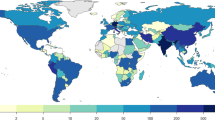Abstract
In order to understand the particular challenges that medicinal plant conservation and management raise at the global level, it is necessary to address issues pertaining their distribution and the environments where they grow. When reviewing medicinal plant studies from eight countries in four regions we found that a high proportion of the reported medicinal plants had wide distributions across countries and continents. Most plants are found wild (40.5%) or naturalized (33.9%), while only 3.3% are cultivated. Since many species are distributed in wild conditions, cultivated and naturalized in several continents, conservation and management interventions would be best served through collaboration between host countries.



Similar content being viewed by others
References
Abe T, Higashi M (1991) Cellulose centered perspective on terrestrial community structure. Oikos 60:127–133
Alcorn J (1984) Huastec Mayan ethnobotany. University of Texas Press, Austin Texas
Balasingh J, Thiruchelthil B, Jerlin B, Samuel A, Muthukumar A (2000) Medicinal flora of a tropical scrub jungle. J Econ Taxon Bot 24:737–745
Balick MJ, Elisabetsky E, Laird SA (1996) Medicinal Resources of the Tropical Forest: Biodiversity and its importance to Human Health. Columbia University Press, New York
Beinart W, Middleton K (2004) Plant transfer in historical perspective: A review article. Environ Hist 10:3–29
Caniago I, Siebert SF (1998) Medicinal plant ecology, knowledge and conservation in Kalimantan, Indonesia. Econ Bot 52:229–250
Casas A, Valiente-Banuet A, Viveros JL, Caballero J, Cortés L, Dávila P, Lira R, Rodríguez I (2000) Plant resources of the Tehuacan-Cuicatlán Valley, Mexico. Econ Bot 55(1):129–166
Coley PD, Barone JA (1996) Herbivory and plant defenses in tropical forests. Annu Rev Ecol Syst 27:305–335
Coley PD, Bryant JP, Chapin FS (1985) Resource availability and plant anti-herbivore defense. Science 230:895–899
Cox B (2001) The biogeographic regions reconsidered. J Biogeogr 28:511–523
Farnsworth NR, Soejarto DD (1991) Global importance of medicinal plants. In: Akerele O, Heywood V, Synge H (eds) The conservation of medicinal plants. Cambridge University Press, Cambridge, UK
Fowler C, Hodgkin T (2004) Plant genetic resources for food and agriculture: assessing global availability. Annu Rev Environ Resour 29:143–79
Frei B, Sticher O, Heinrich M (2000) Zapotec and Mixe use of tropical habitats for securing medicinal plants in Mexico. Econ Bot 54:73–81
Giday M, Asfaw Z, Elmqvist T, Woldu Z (2003) An ethnobotanical study of medicinal plants used by the Zay people in Ethiopia. J Ethnopharmacol 85:43–52
Girón LM, Freire V, Alonzo A, Cáceres A (1991) Ethnobotanical survey of the medicinal flora used by the Caribs of Guatemala. J Ethnopharmacol 34:173–187
González-Tejero MR, Molero-Mesa J, Casares-Porcel M, Martínez Lirola MJ (1995) New contributions to the ethnopharmacology of Spain. J Ethnopharmacol 45:157–165
Halberstein R (2005) Medicinal plants: Historical and cross cultural usage patterns. Annu Epidemiol 15:686–699
Hamilton AC (2004) Medicinal plants, conservation and livelihoods. Biodivers Conserv 13:1477–1517
Hollis S, Brummitt RK (1991) World geographical scheme for recording plant distributions. Hunt Institute for Botanical Documentation, Pittsburgh
Ivancheva S, Stantcheva B (2000) Ethnobotanical inventory of medicinal plants in Bulgaria. J Ethnopharmacol 69:165–172
Kapur SK, Shahi AK, Sarin YK, Moerman DE (1992) The medicinal flora of Majouri-Kirchi forests (Jammu and Kashmir State), India. J Ethnopharmacol 36:87–90
Lirio LG, Hermano ML, Fontanilla MQ (1998) Antibacterial activity of medicinal plants from The Philippines. Pharmaceutical Biol 36:357–359
Moerman DE, Pemberton RW, Kiefer D, Berlin B (1999) A comparative analysis of five medicinal floras. J Ethnobiol 19:49–67
Palacios XF (1999) Contribution to the estimation of countries’ interdependence in the area of plant genetic resources. Food and Agriculture Organization of the United Nations. Background Study Paper No. 7
Posey DA (1984) A preliminary report on diversified management of tropical forest by the Kayapó Indians of the Brazilian Amazon. In: Prance GT, Kallunki JA (eds) Ethnobotany in the neotropics. New York Botanical Garden, New York, pp 112–126
Shrestha P, Dhillion SS (2003) Medicinal plant diversity and use in the highlands of Dolakha district, Nepal. J Ethnopharmacol 86:81–96
Stepp JR, Moerman DE (2001) The importance of weeds in ethnopharmacology. J Ethnopharmacol 75:19–23
Tabuti JRS, Lye KA, Dhillion SS (2003) Traditional herbal drugs of Bulamogi, Uganda: plants, use and administration. J Ethnopharmacol 88:19–44
USDA, NRCS (2004) The PLANTS Database, Version 3.5 (http://plants.usda.gov). National Plant Data Center, Baton Rouge, LA 70874–4490 USA
Voeks RA (1996) Tropical forest healers and habitat preference. Econ Bot 50:381–400
Voeks RA (2004) Disturbance pharmacopeias: Medicine and myth from the humid tropics. Ann Assoc Am Geogr 94(4):868–888
Wiersema JH, León B (1999) World economic plants. a standard reference. CRC Press, Washington D.C
Acknowledgment
M.Aguilar Støen has received support from the Norwegian Research Council project number 158984/510.
Author information
Authors and Affiliations
Corresponding author
Rights and permissions
About this article
Cite this article
Aguilar-Støen, M., Moe, S.R. Medicinal plant conservation and management: distribution of wild and cultivated species in eight countries. Biodivers Conserv 16, 1973–1981 (2007). https://doi.org/10.1007/s10531-006-9125-7
Received:
Accepted:
Published:
Issue Date:
DOI: https://doi.org/10.1007/s10531-006-9125-7




